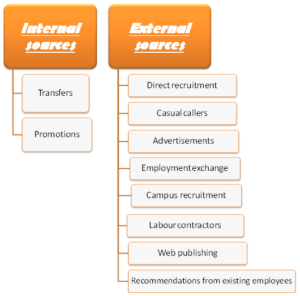Recruitment Process Class 12 is an important topic of staffing as it helps in finding the right human resource for the organization. All the points related to the topic are given below.
Recruitment in Staffing Process Class 12
Recruitment is part of the staffing process and is a very important aspect of staffing. It is called a positive process because of the benefits it offers. Simply put, recruitment is a process of finding candidates for the jobs created in the organizing process. When the jobs and the authority–responsibility relationships are established, then comes the part of getting people for the work. Human resource is a very important part of an organization and getting the most suitable human resource is important. Recruitment as a process helps in attracting employees. Then, stimulating them to apply for the same.
It can be called a linking process. As it links the employee seeker i.e. the company and the job seeker i.e. the employee. It is done through various methods i.e. there are various sources to publish about the vacant job. There are various factors which can affect the recruitment process. These factors are market conditions, labour market conditions, employment and unemployment rate, company image, political conditions, etc.

Process of Recruitment Class 12 is not easy process. It involves a lot of brainstorming as we need to select the right kind of applicant for our vacant job position. The process includes the following steps:
- Searching the sources: there are various sources available where the vacancy can be displayed including online sources, offline sources, print media, electronic media etc. A company needs to find out all the possible sources so that no good source for displaying advertisements can be missed.
- Assessment of their validity: these sources need to be assessed properly so that no good source from where the potential candidates can be reached is missed. These sources should be assessed based on the cost and benefits they offer.
- Choosing the most suitable source/ sources: after analysis of the available sources, choosing the source is next. Choosing the right kind of source is important because it involves cost. If the source does not yield the benefits expected by the company then the efforts, time, energy and money will go in vain.
- Choosing the most suitable candidate: choosing the most suitable candidate is the next step in Recruitment Process Class 12. When the candidates apply for the job after seeing the job description. Then the company may go for the next step including group discussions, interviews and orientation, training etc.

There are various sources available for the appointment and it is not necessary that they will be chosen externally. Many times internally the position is fulfilled. These sources are thus of two types:
- Internal sources
- External sources

Internal sources under Recruitment Process Class 12
Internal sources mean that the vacant position is filled by the employees of the company itself. They are mainly of two types- transfers and promotions.
- Transfers: transfers are simply a shift. It is a shift of an employee from one department to another department, from one shift to another shift, and from one branch to another branch. It does not involve any substantive change in the employee’s status. Although, it will have some impact on the duties and responsibilities. When any department is overstaffed then transfers are a really good source to fill up the vacant position from there. Due to no substantive change in the status of an employee, salaries also do not necessarily change. That is why it is called the horizontal movement of employees.
While transferring the employee from one position to another, their skill set should be analysed carefully. It should be ensured that the employee will be able to perform the task effectively.
- Promotions: promotions are altogether different from transfers. Where the transfers are horizontal movement, promotions are the vertical movement of employees. It means that the employee is shifted from a lower position to a higher position. Higher position involves changes in duties, responsibilities, time demanded, the status of the employee and salary.
Promotions are a morale booster because it is kind of a reward for the good work that the employees do. It provides employees with satisfaction and psychologically they feel good about their work and company.
Merits of internal sources
- Motivation of employees: when transfers and promotions take place and there is a hike in the salary of the employees then they are motivated to perform better through learning and practice. They work effectively and efficiently and give their best shot at their work so that they also get a chance to get promoted in the organization.
- Simplification of the process: Recruitment Process Class 12 states that every organization needs to evaluate the candidate before their selection for the job. Internal recruitment will simplify this process as the employees are already known to the organization and their skills and the way they work are known.
- A tool for training: transferring the employees can also be considered job rotation. Wherein, the employees are transferred from one job to another so that they learn about the work other than their own position and thus they get trained by working themselves.
- Balance of workforce: sometimes, there are overstaffed departments in the organization. They thus waste efforts, and time and increase the overall cost of the firm. Transfers and promotions will help in balancing the workforce by fulfilling the places of understaffed departments from the workers of overstaffed departments.
- It is a cheaper source: when recruitment is done from external sources then the cost is involved while recruiting from an internal source does not involve huge costs and will be a cheaper way to fill the position.
Limitations of internal sources under Recruitment Process Class 12
- Scope is limited: while transferring or promoting the employees, the scope for getting a fresh talent with an increased skill set is reduced. New people in the organization are necessary to keep the new life in the organization.
- May reduce enthusiasm: when the employees know that promotions are fixed and there will be a promotion of the employees from time to time, then they will lose motivation and become reluctant to perform better and more efficiently.
- Quantitative limitations: when the organization tries to fill all the vacancies from internal sources then it becomes difficult because it is not possible to fulfil each requirement from the available talent in the firm especially if the organization is new.
External sources under Recruitment Process Class 12
External sources are the sources outside the firm. These sources include:
- Direct recruitment: direct recruitment involves a display of vacancies in the position of the firm and it is displayed outside the organizational premises. When the job seekers see the poster they assemble it outside the premises and then they are selected randomly or from a short test of their skills based on the kind of work. This is usually done for unskilled or semi-skilled work, wherein they are paid on a daily wage basis without appointing them specifically for a position.
- Casual callers: when the job seekers apply and the position is not vacant then their information is kept intact in the database so that whenever there is any vacancy in the organization and if they are suitable based on their skills and qualifications then they are called for the next process, that can be the interview or group discussions.
- Advertisement: advertisement can be displayed or published in television, newspapers, or other print media. It helps to fill various positions of a firm as it has a scope of displaying about the company also. Although, due to its wide scope it brings a lot of responses and thus leads to confusion and takes a lot of time in eliminating the unsuitable candidates and selecting the suitable one.
- Employment exchanges: employment exchanges are the organizations or institutes where job seekers give information about their qualifications and other details along with their resumes. They act as a link between the organization and the job seekers as they provide information about the various candidates to the companies. Although they are not so up to date and can give information that is not helpful.
- Campus recruitment: campus recruitment means that the person is recruited from the campus of the college itself. Many companies are in close contact with the colleges and when the term ends, they go for recruiting people for the vacant job. This is done for managerial and technical staff. This helps in getting the people who have studied in a good environment and the company can be certain about their quality.
- Labour contractors: labour contractors are the people who are in close contact with the workers/labourers. This is helpful in filling up the position for unskilled or semi-skilled work. Although these labour contractors are also the employees of an organization and when they decide to leave, the labourers will also leave and this may create chaos in the organization thus they should be selected based on their work and how trustworthy they are.
- Web publishing: the internet is gaining importance. This is becoming a new source of recruitment. There are various ways through which the vacancy can be displayed such as naukri.com, LinkedIn, Intern Shala, Instagram pages, jobstreet.com etc.
- Recommendations from existing employees: here, the existing staff acts as a link between the potential candidates and the company. They recommend the position to their friends or family member. This is helpful because the existing employee knows about the company and its working and also knows about the people who are applying and about their skills.
Merits of external sources
- Qualified personnel: through external sources, skilled and knowledgeable people can be recruited. There should be a flow of freshly skilled people in the organization for getting a mixture of experienced people and fresh minds.
- Wider choice: external source has a wider choice in comparison to the internal source. Internally only the existing employees can be taken for the vacant job but externally there are many candidates waiting for the job and thus many would apply.
- Competition booster: when the company employs people from external sources then the existing staff may feel like competing with the new ones to maintain their position. This will improve healthy competition in the firm.
Limitations of external sources under Recruitment Process Class 12
- Lengthy process: external source recruitment is a lengthy process because it involves careful analyses of the candidates. First, the company needs to publish the vacancy in different sources, then they would apply and the company needs to wait for the response. Then further tests or elimination processes can be done and thus takes a long time.
- Costly process: theses sources are costlier than the internal sources. Money needs to be spent on the publishing and application process.
- Dissatisfaction among existing employees: there is a competitive spirit among the existing staff as they feel that their promotion chances are reduced. But when the competition becomes unhealthy then the growth of an organization suffers.
Conclusion
There are various factors that influence the Recruitment Process Class 12 such as the size of the company, the labour market conditions, the rate of growth etc. Recruitment is thus the first step in the staffing process which helps in the elimination of unsuitable candidates and the selection of suitable candidates. This is a very important process as it initiates the staffing process by stimulating the employees to apply for the job.
Chapter 6 – Staffing
- Need and Importance of Staffing
- Staffing as a part of Human resource
- Introduction to recruitment
- Training and development